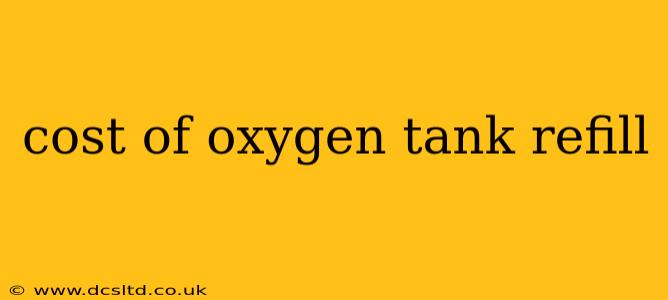The cost of refilling an oxygen tank varies significantly depending on several factors. Understanding these factors will help you budget appropriately and ensure you get the best value for your needs. This guide breaks down the influencing elements and provides you with a clear picture of what to expect.
What Factors Influence the Cost of Oxygen Tank Refills?
Several key factors contribute to the final price you'll pay for an oxygen tank refill:
-
Tank Size: Larger tanks naturally hold more oxygen and require more to refill, leading to a higher cost. Smaller, portable tanks are generally cheaper to refill than larger, stationary ones.
-
Oxygen Purity: Medical-grade oxygen (typically 99.5% pure) is more expensive than industrial-grade oxygen. The purity level required depends on your specific needs, as prescribed by your doctor.
-
Location: Prices vary geographically due to differences in oxygen supplier competition, transportation costs, and local regulations. Rural areas might see higher prices due to transportation expenses.
-
Supplier: Different suppliers have varying pricing structures. Some may offer discounts for bulk refills or for those with long-term needs. Comparing prices from several suppliers is crucial.
-
Delivery: If you need home delivery, this will add to the overall cost. Consider the convenience fee against the effort of transporting the tank yourself.
How Much Does an Oxygen Tank Refill Typically Cost?
Giving a precise price is difficult due to the variable factors mentioned above. However, you can expect a range. A refill for a smaller, portable tank might cost anywhere from $20 to $50, while larger tanks could range from $50 to well over $100. Again, location and supplier significantly impact the final cost.
Where Can I Get My Oxygen Tank Refilled?
Several options exist for getting your oxygen tank refilled:
-
Medical Supply Companies: These are the most common source for medical-grade oxygen refills. They often offer convenient delivery services.
-
Home Healthcare Providers: If you're receiving oxygen therapy as part of your healthcare plan, your provider may handle refills as part of your treatment.
-
Welding Supply Stores: These stores sometimes offer oxygen refills, but it’s crucial to ensure the oxygen is medical-grade if needed for therapeutic purposes. Industrial-grade oxygen is not suitable for medical use.
-
Independent Oxygen Suppliers: Smaller, independent suppliers may also provide refill services, sometimes at competitive prices.
What are the Different Types of Oxygen Tanks?
There are various oxygen tank types, impacting cost and portability:
-
Portable Tanks (E and D cylinders): Lightweight and easy to transport, ideal for individuals on the go.
-
Larger Stationary Tanks (M and G cylinders): Offer a larger oxygen supply, suitable for home use. These are typically more expensive to refill.
How Often Do I Need to Refill My Oxygen Tank?
The refill frequency depends entirely on your oxygen flow rate and the tank's size. Your doctor or respiratory therapist will determine the appropriate flow rate based on your individual needs. They can also advise you on the expected refill schedule.
Can I Refill My Oxygen Tank Myself?
No. Refilling oxygen tanks is a hazardous procedure that requires specialized equipment and training. Attempting to refill your tank yourself can be incredibly dangerous. Always use licensed and qualified suppliers for refills.
Conclusion
Determining the precise cost of an oxygen tank refill necessitates considering various factors, including tank size, oxygen purity, location, supplier, and delivery options. By understanding these variables, you can make informed decisions, compare prices effectively, and ensure you receive the appropriate medical-grade oxygen for your needs at a reasonable cost. Always consult with your healthcare provider or respiratory therapist regarding your oxygen therapy and refill requirements.
